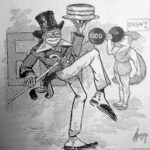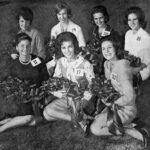Over the course of a century, the Pasadena High School Chronicle, now the Pasadena City College Courier, has seen multiple social paradigm shifts. As the decades passed, the social attitudes of the general public, and by extension the Chronicle/Courier staff, changed as advancements in civil rights were made, most notably with the Civil Rights Act of 1964, which brought an end to segregation and made institutional discrimination illegal.
During its formative years in the mid to late 1910s, the Chronicle regularly published cartoons and articles that weren’t in the best taste, at least according to contemporary standards. One cartoon from a 1916 edition crudely depicted a black man, or a white man in black face, tapping away with a cane on stage. It was a condescending look at black culture and a classic example of racial stereotyping.
Of course, at this time these depictions were typical as Jim Crow laws were in full effect.
In the 1940s, however, a majority of the published articles did not touch upon racial situations or anything that pertained to non-white populations. There was the occasional article that had the word “Negro” in its headline and another, yet non-derogatory headline mentioned Jackie Robinson, who attended the previously named Pasadena Junior College.
By the time the 1960s rolled around, the Courier leaned on the more progressive divide of American thought on racial integration. Much of the articles on race issues were pretty positive, even before the Civil Rights Act passed in ’64.
Besides rallying for integration, the staff of this era ran articles displaying the perceived institutional racism. On a local level, the Tournament of Roses was called out during the search for the 1964 Rose Queen since the finalists were all white.
The Tournament of Roses issue became much larger than a one-and-done article. Once the local chapter of the NAACP claimed their words were taken out of context by the Tournament officials, the Courier staff was quick to follow the story.
Another important piece to this developing story was the fact that the staff ran a few letters to the editor (when the public actually wrote in) discussing the Rose Queen dilemma. Some agreed that racism was an excluding factor, some didn’t.
One minor change in the Oct. 14, 1964 edition was the wording of a headline that read “Afro-American Debates Students at YR [Young Republican] Meeting.” The headlines at this time commonly used “Negro” in place of “Afro-American,” and the only reason for the sudden change in this specific headline was due to the person the article talked about.
The person in question was Tut Hayes, chairman of the Afro-Americans for Goldwater Association. The Goldwater Association was named after Barry Goldwater, an Arizona senator who opposed the passage of the Civil Rights Act.
As the headline suggests, Hayes came off argumentative to the student audience. He claimed that most of the problems the black community faced at the time were actually brought upon by themselves. Other claims were that “the black community must do something for itself” and “it is not the white man’s problem to solve the Negro’s problem.” The student response to these claims were very negative, to the point where they began to boo Hayes.
The amount of awareness the paper had during this decade was no doubt due to racial tensions coming to a head.
In a different vein, the 1940s brought a new change to one of the newspaper’s pages. The Oct. 4 , 1940 issue happily announced the addition of a women’s page, a weekly addition that would cover women’s interests ranging from fashion to women’s sports, edited by Mary Bacon. According to the article that reported the page’s upcoming debut, this would be the first time since women’s suffrage was recognized in 1920 that a whole page would be devoted to women’s interests.
At the time, the Chronicle came out every Tuesday and Thursday, yet the women’s page would only appear in Tuesday editions.
Another piece from the Mar. 18, 1964 edition, Vicky Hutchins’ “’Modern Woman’ Must Face Confusing Social Requirements,” pointed out the ways that society expects women to act and the subtle forms of sexism that go along with them.
The year 1972 brought a few changes of its own for women in college with the passage of Title IX, part of the Education Amendments of 1972, which outlawed sex-based discrimination in educational institutions that receive federal funding and the programs they hold.
Most instances of Title IX in the news are related to sports programs in higher education institutions. In terms of teams, there has to be an equal, or as close to equal, amount of athletic opportunities for both men and women.
Where women’s teams previously didn’t exist, they were created. If there were still too many men’s teams, some would unfortunately be dropped.
Such was the case for PCC, and the impact of Title IX on campus was recorded in a 1999 article.
At the time, the men’s tennis team was a thing of the past while the women’s team still existed (until 2004 when women’s tennis would be cut due to the removal of the courts). In the article, there were strong feelings about men’s teams getting cut in favor of balancing out with the amount of women’s teams.
However, it wasn’t just a matter of cutting men’s teams, as the head volleyball coach at the time, Lori Jepsen, questioned the nonexistence of a men’s volleyball team and happily welcomed the thought of one being formed.
The most recent and ever-evolving shift in society’s views is the perception of homosexuality, and later, the other components of the LGBTQ community.
Jumping back to the 1970s, the Courier’s early mentions of the LGBTQ community, exclusively about gay men, were seen in an article titled “Homosexuality Not Always Key to Relationships Between Men,” written by Luaine Scheliga.
In her article, Scheliga argued that the media at the time tried to equate deep male relationships as homosexual relationships in films such as “Butch Cassidy and the Sundance Kid” and “Midnight Cowboy.” She goes on to question why the depictions of these friendships are “unholy” before asking if it was possible for love to exist in same-sex relationships “without … reading some aberration in it.”
The article ends by stating that the image of such loss is a “powerful and lasting memory” since it’s a relatable experience, but “we don’t have to be homosexual to know it,” which sounds partly condescending and understanding at the same time.
Skipping ahead to 1984, a “Students Speak Out” section of the Courier asked for student opinion about whether or not same-sex couples should be allowed to adopt children.
Five of the six published responses were against the idea of gay/lesbian couples adopting because it would be “immoral” and would confuse the child from distinguishing who the mother and father figures were.
More recently, as in the year 2000, the Jan. 27 “In Your Opinion” section posed the question of whether same-sex marriage should be legal in California. While there were only four published responses to this question, the overall tone of the answers were more accepting of same-sex couples compared to a similar question from 16 years earlier.
Along with a heightened awareness for issues regarding gay and lesbian individuals, the latest social advancement that has been documented is the attention to transgender lives.
Though transgender individuals put the T in LBGTQ, they have often been forgotten in the fight for equality amongst their lesbian, gay and bisexual peers. And while there has been a change in attitude toward the rest of the LGBTQ community, transgender rights still lag behind the rest.
Articles on transgender issues started to appear in the late 2000s, specifically in October 2007 when the idea of gender neutral restrooms were proposed by Associated Students Vice President of Public Relations Adam Kratt.
Kratt proposed the idea to give a safe space to transgender students who faced harassment and the possibility of being arrested for entering restrooms that do not correspond to their biological sex.
Following the story into November, the proposal to convert a single restroom in the C building moved forward and only needed to be approved by the Board of Trustees. That was the last article published about the proposal, and as evidenced by the restrooms currently on campus, the proposal was struck down.
During that same month, Andrew Gomez, a transgender student, wanted to run for homecoming king. The homecoming committee initially prevented Gomez from participating, claiming he was denied due to his piercings. The fact that another potential candidate had piercings and was not denied participation like
Gomez was led many to believe it was due his transition from female to male.
The reporting of these events were done by a single person, Peter Herrero.
Within the past year, many LGBTQ-centric articles have appeared in the Courier’s pages ranging from the Chick-Fil-A dilemma surrounding the business’ location near the campus to the 2014 commencement scandal involving the Board of Trustees rescinding their invitation and later re-inviting Dustin Lance Black as the commencement speaker.
Of course, these examples are only a slim picking of the expanse of writing dealing with civil rights that was covered over the paper’s century of existence. And while no one can predict what the next major movement will be based upon, it will be a newsworthy change whenever it happens.
Whatever the future leads up to, the Courier’s conscience will continue to grow though the paper itself may be just a website. Hopefully when the time comes for another milestone celebration, that generation of writers look back at the expansive history of the Courier and realize how different their society is to ours.
- Video games, its culture, needs to patch itself to be respected - November 26, 2019
- Courier Convos: Reporting on Religion - November 11, 2019
- Courier Convos: Dispelling Magical Misconceptions - October 24, 2019




